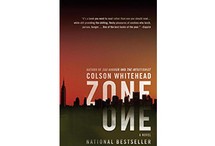Compulsively Readable Paperbacks
Check out these 10 new releases, plus some of our old favorites.

9 of 21
Zone One
By Colson Whitehead
336 pages;
Anchor
Imagine this: Michelangelo drawing a graphic novel where exquisitely painted super-hero angels rule reality. That in a nutshell is what novelist Colon Whitehead has chosen to do by writing a zombie novel—apply his virtuosic literary talents to a horror genre novel—except that, the novel is anything but genre and the horror revolves around the same kind of thinking that has produced thought-provoking post apocalyptic novels such the The Road.
Our narrator is one Mark Spitz who works as a sweeper, cleaning out a Manhattan building of "skelts" (i.e., flesh-eating zombies) or what are known as "stragglers" (individuals stuck in a particular moment in time, say, making copies at their office or inflating party balloons) all of whom were infected with a plague several years prior. As he and his team work on reconstructing the city in order to make it habitable again, he thinks about his past (our present) society, reflecting on everything from sitcom stars' haircuts to chain eateries with fake memorabilia to leather sectionals in the average American living room—not to mention how "public relations" shape our collective view of the world (sadly, PR still has a place in this ash-covered universe). As witty and spot on as this commentary is, however, it's Spitz's moments of reflection that elevate this story into the compelling. How has he survived when so few others have? And what is it about living that people all prize so much, even in the face of total destruction? "It happened every so often that he recognized something in these monsters, they looked like someone he had known or loved," writes Whitehead. Humanizing even your human-eating enemy—it's a point so clever it's almost funny. Except that it makes you re-think how we look at our non-zombie foes, the ones in real life who we sometimes have such trouble understanding as, well, human.
— Leigh Newman
Published 12/02/2011


